Smartphones Help the Hearing Impaired Use Public Transportation: Developing Japan’s First Barrier Free Software on Board
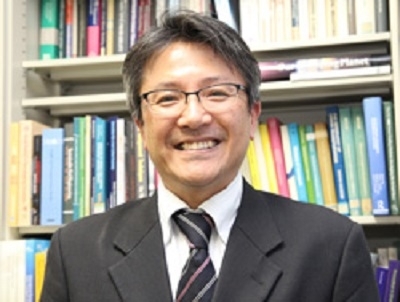
We talked to Professor Akimasa Fujiwara, Development Technology Course, Division of Development Science, Graduate School for International Development and Cooperation.
(February 8th, 2011, Interviewed by Public Relations Group, Community Collaboration and Information Policy Office)
Overview
Professor Fujiwara is a specialist in transportation engineering. His research is about the development of general transportation infrastructure that supports the greater mobility of people. This edition of “Research Now” is about the development of application software for smartphones to help the hearing impaired use public transportation.
In fact there are several types of mapping or traffic conditions software that already exist, but there is no service yet that meets the needs of hearing impaired people. This is important as there are some hearing impaired people who do not have full confidence in their safety when they travel. Buses are a typical form of public transportation, and people with hearing difficulties are usually reluctant to take buses, so Professor Fujiwara began to develop support software to assist them via visual guidance.
Under the current circumstances, hearing impaired people have few opportunities to go out for their leisure. It is difficult for them to spontaneously go somewhere by themselves and even for going shopping it is often necessary to be accompanied by a family member or a helper. Hearing impaired people say that they feel unsure about the destination of the upcoming bus or about the location of the next bus stop. In general, they avoid travelling alone. Professor Fujiwara already carried out many pilot programs regarding the problem of disabled people in public transportation in the past. Therefore he recognized this situation and already had a keen desire to help the hearing impaired to improve their mobility several years ago.With regards to the issue of disabled people in public transportation, the Ministry of Land, Infrastructure, Transport and Tourism commissioned a publicly funded project and Professor Fujiwara was successful in his application for the project. He received four million yen in funding and started research last October with the intention to complete it within this academic year. Taking advantage of the smartphone’s scalability and the fact that the smartphone has gone mainstream recently, this is Japan’s first attempt to provide transportation-oriented software on board with the aim of assisting the hearing impaired.
*The Asahi Shimbun published about this support software development on Monday June 6, 2011.
Using the Smartphone as a Tool to Aid the Hearing Impaired
The main purpose of the software being developed is to assist hearing impaired people in taking buses. The screen of the smartphone shows the correct timing to get off the bus and relieves hearing impaired persons from the worry of missing their stop due to inaudible bus announcements.
First, the passenger chooses the destination on the screen of the smartphone. While the bus moves in the direction of the destination, the following messages appear on the screen: “We are now approaching “Sensuikan Mae” (name of the next bus stop). This bus will arrive there in 25 minutes. (Figure 3) When the bus approaches the destination, the phone vibrates and the message on the screen shows the following: “We will soon make a brief stop at “Sensuikan Mae” (name of the bus stop). Please get ready to get off.” (Figure 4) At the same time the bus fare is displayed so that the hearing impaired passenger has enough time to prepare for payment of the fare.
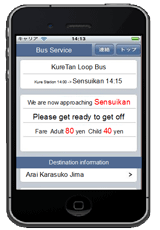
Figure 1. The screen is designed for high legibility
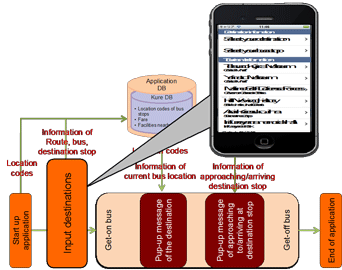
Figure 2. How to input the destination
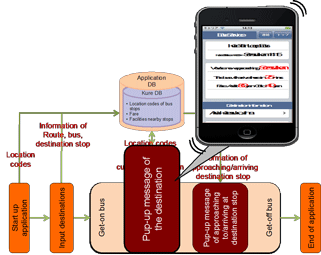
Figure 3. Information during the bus ride
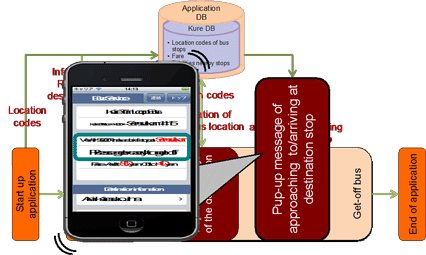
Figure 4. Notification of the next destination
The position of the bus is tracked by the global positioning system (GPS). The server recognizes the position data sent by GPS, transforms the data to textual information and sends it automatically to the smartphone. (Figure 5)
In planning this system, Professor Fujiwara especially took the following four points into account:
1) Design of the display: It is designed to be easily viewable even by elderly people. The standard font size is 18pt and reader friendly.
2) Operability: The characteristics of the smartphone are the intuitive user interface and the large screen. The software is designed to be user friendly.
3) Contents of the displayed transit information: Putting priority on the information that is the most important for the passengers.
4) Notification of destination arrival: There are two notifications that are transmitted to the user via the smartphone’s vibration function. The first notification is en route between the previous bus stop and the next stop the bus is heading towards. The second notification is immediately before arriving at the user’s requested destination. These notifications help to reduce the hearing impaired passenger’s worries about his current location and the correct timing in getting off the bus.
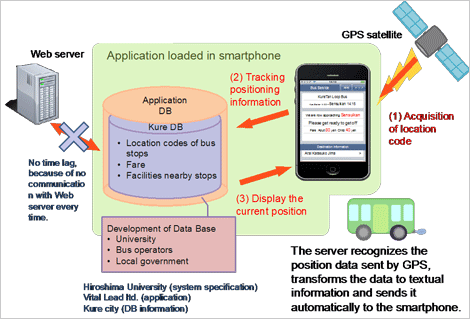
Figure 5. How textual information is transferred to the smartphone
Experiment to Test the Software
In order to verify the four features mentioned above, Professor Fujiwara decided to conduct an experimental demonstration run of the software by using it to navigate to several sightseeing destinations that are commonly visited by bus in the city of Kure in Hiroshima Prefecture. On January 16, 2011, eleven citizens from Hiroshima, all with hearing disabilities, took part in the experiment in visiting sightseeing destinations by bus using the newly developed smartphone software. The participants were divided into 6 groups and each participant was given a smartphone. The participants then had to ride the “Kuretan” Kure Touring Loop Bus in order to visit sightseeing spots such as the Yamato Museum or the Irifuneyama Memorial Museum by themselves.
After the experiment finished, an interview survey with sign language interpreter was conducted among the participants and the participants’ responses were generally positive. The participants reported that the screen was easily viewable and the smartphone itself was user friendly. Most of all, the participants really appreciated the ability to check the current location and fare during the bus ride.
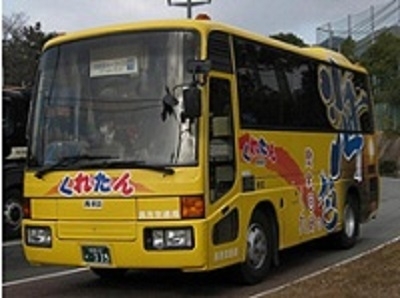
Kure Touring Loop Bus “KureTan”
Many people with hearing disabilities have almost no opportunity for leisure travel without being escorted by a family member. Also, among our eleven participants, although all of them live in Hiroshima prefecture, none of them had ever been to Kure for sightseeing. That means that they only go out when necessary, and can’t travel alone freely. We wish that even those with hearing disabilities could go out and enjoy their leisure time. The survey findings showed that with the assistance of the software on the smartphone, even people with hearing disabilities can easily travel alone freely.
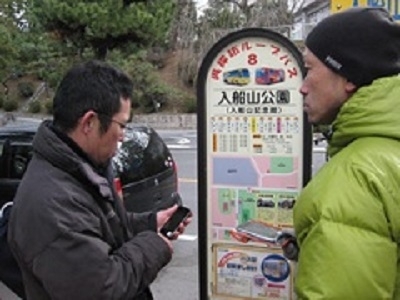
Participants using their smartphones at a bus stop
Areas of Improvement
The experiment revealed two points to improve upon.
The first point was the strength of the vibration function in the smartphone. The vibration function of the smartphone used for this experiment (Apple’s iPhone) was weaker than that of a common mobile phone. Some participants pointed out that it was difficult to notice the vibrations from the smartphone. The participants consisted of three levels of hearing impairment: Level 1, 2 and 3. Among the eleven hearing impaired persons, six had Level 1 hearing impairment while four had Level 2 hearing impairment., and the rest 1 had Level 3. Level 1 hearing impairment means that persons can not hear sounds at all, while Level 2 hearing impairment means that persons can only hear sounds over 100 dB by using both ears. And Level 3 means that persons can hear sounds over 90 dB by using both ears, so that they cannot catch loud voice without auricle contact. To put this into perspective, 100 dB is the sound you hear when standing underneath an elevated railway track with the train passing by. Therefore people with Level 2 hearing impairment can hear almost nothing at all. They rely completely on the vibration function of the smartphone, so it is necessary to intensify the vibration.
The second point is the importance of knowing the conditions of the bus service. The accuracy of bus services is influenced by the weather and traffic conditions. The participants were worried about things like: “Is my bus on time?”, “Could it be that the bus is delayed?” and “Can I arrive in time?” Some of them said that they became anxious because there was no way to check the conditions of the bus service. To improve this situation it will be necessary to get access to the data provided by the bus company’s bus location system(*1).
(*1)This is a system used to define the real time location of a bus by GPS. It is also used to adjust the regular bus.
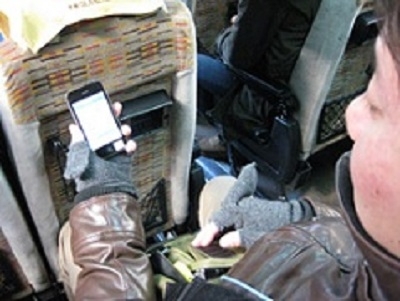
A participant riding a bus and checking messages
Towards Practical Use - Providing a Seamless Transportation Support System
Professor Fujiwara said that the cooperation of local governments is absolutely necessary in realizing the practical use of this system in the future.
In reality, buses don’t simply run in a loop such as in the case of the sightseeing bus. In urban areas, a number of buses run in complicated routes. In getting to their destination, passengers might also transfer to other modes of transit like the streetcar or the train in addition to riding the bus.
Therefore it is necessary to obtain the data regarding the timetables and fares of the transportation service provider of a certain community. Professor Fujiwara thinks that with the help of this data, it would be possible to provide a more comprehensive and seamless(*2) way of supporting the travel of hearing impaired persons from their home to their destination.
(*2)“Seamless” means without interruption. Rendering seamless of transportation systems means to eliminate interruptions of the traffic flow, such as walking around on terminals or boarding and to make travelling smoother by improving both the hardware and the software. In particular, it includes measures to realize accessible transport, connections on the same platform, mutually direct connections, the creation of connection time-tables, the enlargement of discounts and the introduction of universal train, bus and ship tickets. (Quoted from the homepage of the Land, Infrastructure and Transportation Ministry, originally in Japanese)
As we mentioned before, Professor Fujiwara’s specialty is in transporting engineering. When he was a student, he studied civil engineering concentrating in the area of transportation, and dreamed about being involved in building large infrastructure projects like the Seto-Ohashi Bridge(*3). However, during his studies he became more interested in the fundamental issues like the societal needs of a certain project and the improvement of existing infrastructure. Currently, he is affiliated with the Graduate School for International Development and Cooperation and is doing research not only about the situation in Japan, but also in other foreign countries (mainly in Asia). For example, Bangladesh is still a developing country that is saddled with poverty, but many people have mobile phones. Therefore Professor Fujiwara said that “the newly developed software for supporting hearing impaired persons could possibly be localized in the future to a developing country to help their needs.”
(*3) A bridge that connects the main island of Japan (Honshu) to Shikoku
Pursuing perfectly barrier free society
Professor Fujiwara’s final target is a seamless transportation system. A perfectly barrier free society is a world without physical or psychological obstacles limiting the free movement of people. This time, persons with hearing disabilities benefitted from his research, but his research could also be applied towards helping tourists and foreigners navigate unfamiliar places. As a result, he will continue his research to create transportation infrastructure systems which allows everyone to travel safely or enjoy leisure without constraint and social inequities.
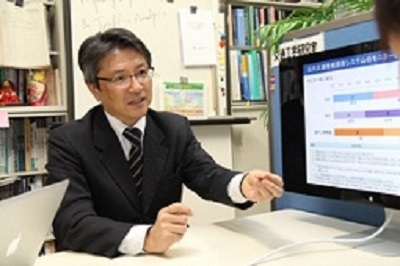
Professor Fujiwara is pursuing perfect Barrier-free
Postscript
I thought that the present transportation infrastructure system was already quite sophisticated, but from the passengers’ point of view, there is still a lot of room for improvement. This project is attracting a great deal of public attention. Other universities invited Professor Fujiwara to do joint research and also he receives many inquiries from users. “The motivation for the development of this software was the wish to contribute to society”, Professor Fujiwara said. When I saw how hard he works to reduce social inequalities in transportation, I could feel that he is a compassionate professor. (by Ryosuke Hayashi, 4th Year Student in the Faculty of Education)


 Home
Home

